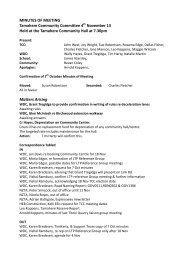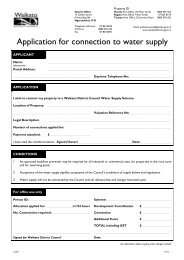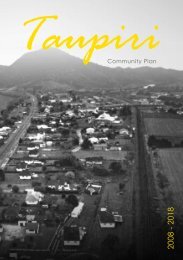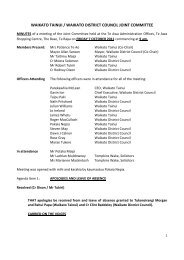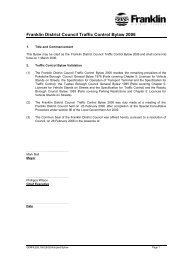1.2 Purpose of this waste assessment - Waikato District Council
1.2 Purpose of this waste assessment - Waikato District Council
1.2 Purpose of this waste assessment - Waikato District Council
- No tags were found...
Create successful ePaper yourself
Turn your PDF publications into a flip-book with our unique Google optimized e-Paper software.
and <strong>of</strong>fensive trades (Third Schedule). The Health Act enables TAs to raise loans for certain sanitary works and/or to receive government grants and subsidies, where available. 31.3.5 The Hazardous Substances and New Organisms Act 1996(the HSNO Act)The HSNO Act addresses the management <strong>of</strong> substances (including their disposal) that pose a significant risk tothe environment and/or human health. The Act relates to <strong>waste</strong> management primarily through controls on theimport or manufacture <strong>of</strong> new hazardous materials and the handling and disposal <strong>of</strong> hazardous substances.Depending on the amount <strong>of</strong> a hazardous substance on site, the HSNO Act sets out requirements for materialstorage, staff training and certification. These requirements would need to be addressed within operational andhealth and safety plans for <strong>waste</strong> facilities. Hazardous substances commonly managed by TAs include used oil,household chemicals, asbestos, agrichemicals, LPG and batteries.The HSNO Act provides minimum national standards that may apply to the disposal <strong>of</strong> a hazardous substance.However, under the RMA a regional council or TA may set more stringent controls relating to the use <strong>of</strong> landfor storing, using, disposing <strong>of</strong> or transporting hazardous substances. 41.3.6 Resource Management Act (1991) (RMA)Although the RMA focuses on the environmental effects <strong>of</strong> activities, in practice there is a significant crossoverbetween environmental impacts and human health impacts. Therefore many <strong>waste</strong> management activities thatare likely to have public health impacts are controlled through the RMA. This may include site discharges suchas odour, groundwater contamination, particulates and other aerosols, presence <strong>of</strong> vermin etc.1.3.7 Key <strong>waste</strong> management public health issuesKey issues that are likely to be <strong>of</strong> concern in terms <strong>of</strong> public health include the following:• Management <strong>of</strong> putrescible <strong>waste</strong>s• Management <strong>of</strong> nappy and sanitary <strong>waste</strong>s Management <strong>of</strong> putrescible <strong>waste</strong>s• Management <strong>of</strong> nappy and sanitary <strong>waste</strong>s• Potential for dog/seagull/ vermin strike• Timely collection <strong>of</strong> material• Management <strong>of</strong> spillage• Litter and illegal dumping• Medical <strong>waste</strong> from households and healthcare operators• Storage <strong>of</strong> <strong>waste</strong>s• Management <strong>of</strong> hazardous <strong>waste</strong>s• Private on-site management <strong>of</strong> <strong>waste</strong>s (burning, burying, rural <strong>waste</strong> management etc).1.3.8 Management <strong>of</strong> public health issuesBroadly speaking, <strong>waste</strong> management related public health issues are likely to relate more to how specificprocesses are managed than to processes themselves. From a strategic perspective the above issues are likelyto apply to a greater or lesser extent to virtually all options under consideration. For example illegal dumpingtends to take place ubiquitously, irrespective <strong>of</strong> whatever <strong>waste</strong> collection and transfer station systems are inplace. Some systems may exacerbate the problem (infrequent collection, user charges, inconveniently locatedfacilities etc.), but by the same token the issues can be managed through methods such as enforcement,education, providing convenient facilities etc.In considering how public health issues should be addressed in the context <strong>of</strong> <strong>this</strong> <strong>waste</strong> <strong>assessment</strong> the viewis taken that public health issues are likely to present at least some level <strong>of</strong> risk across all options. Public health3 From: MfE 2009: Waste Management and Minimisation Planning, Guidance for Territorial Authorities.4 From: MfE 2009: Waste Management and Minimisation Planning, Guidance for Territorial Authorities.8



